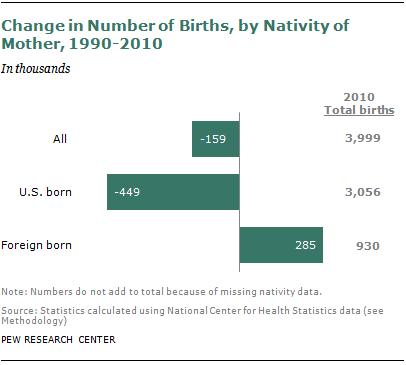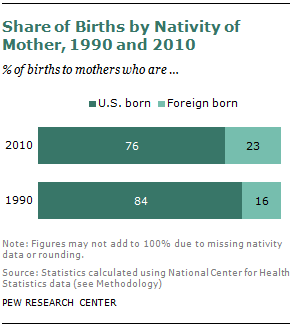
Immigrant mothers accounted for 23% of U.S. births in 2010, an increase from their 16% share in 1990, but a slight decrease from their 25% peak share in 2005-2007. The share of births to foreign-born mothers is higher than the proportion of immigrants in the overall population, which also has risen during this period. In 1990, immigrants were 8% of the U.S. population, and in 2010 they were 13%.
Overall U.S. births declined slightly from 1990 to 2010, to 4.0 million from 4.2 million. Birth trends diverged for foreign-born and U.S.-born mothers over this period. Births to U.S.-born women, which numbered 3.5 million in 1990, decreased or did not change in most years since then. Births rose in 2006 and 2007 before declining over the next three years, by 5%, to 3.1 million in 2010. Over the entire 1990-2010 period, births to U.S.-born women declined by nearly 450,000, or 13%, to 3.1 million.
By contrast, births to immigrant women, which numbered 646,000 in 1990, rose each year but one until peaking in 2007, at 1.1 million. From 2007 to 2010, they fell by a marked 13%, to 930,000. Over the entire 1990-2010 period, births to immigrant women grew by more than 280,000, or 44%.
The largely contrasting fertility patterns of U.S.-born and foreign-born women had the net effect of producing a small rise in the total number of births over the 1990-2007 period. But from 2007 to 2010, total births decreased 7%, with births to U.S.-born women declining by a modest 5% and births to immigrant women dropping by 13%.

From 2007 to 2010, the number of U.S. births shrank by more than 300,000. A sharp decrease in births to immigrant women accounted for more than 40% of the overall decline.
One reason that immigrant mothers account for a disproportionate share of births is that immigrants are more likely than others to be in their childbearing years. Among immigrants in 2010, 25% were women ages 15-44, compared with 19% of the U.S.-born population. Over the 1990-2010 period, the number of immigrant women of childbearing age grew by 85%, while the number of native-born women of childbearing age dwindled by 1%.
Looked at another way, among all women of childbearing age, 17% were immigrants in 2010, an increase from 10% in 1990.
Another measure of childbearing—the birth rate, or children born per 1,000 women ages 15-44—was 87.8 for immigrants in 2010 and 58.9 for U.S.-born women. Birth rates for both groups have declined markedly since 1990—by 11% for U.S.-born women and by 22% for foreign-born women. From 2007 to 2010, there was an especially sharp decline in birth rates for immigrant women—14%, compared with a 6% decline for U.S.-born women.
The sharper decline in birth rates to immigrant women compared with native-born women has closed the gap in birth rates somewhat over the 20-year period. In 1990, the birth rate for immigrant women was 70% higher than for native-born women. In 2010, it was 49% higher.
Another measure of fertility—children ever born—indicates the number of children that women nearing the end of their childbearing years have had in their lifetimes (including those who have had no children). According to the Current Population Survey, this number is an average 2.1 for immigrant women, and 1.8 for U.S.-born women.9




